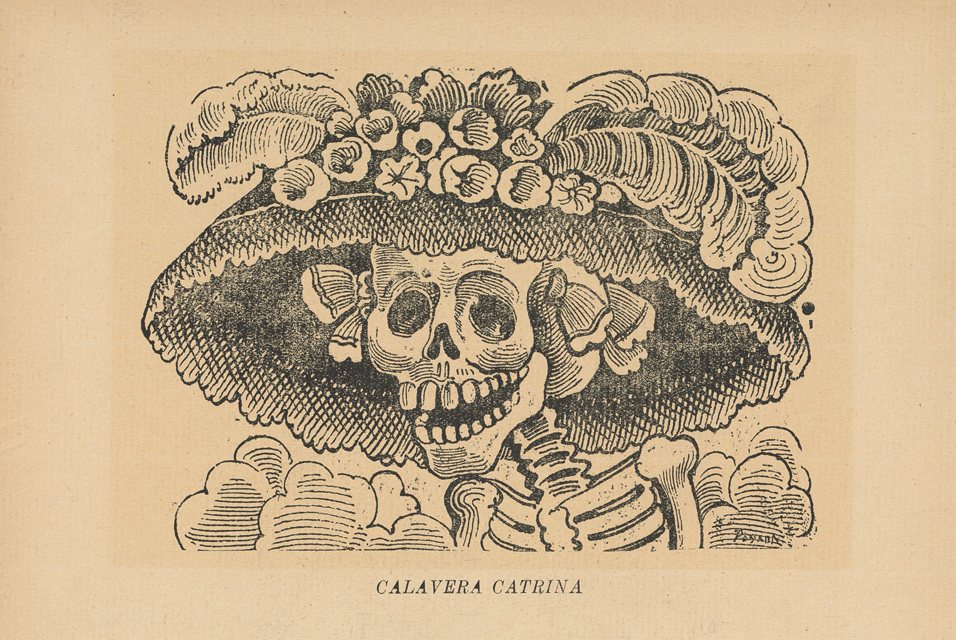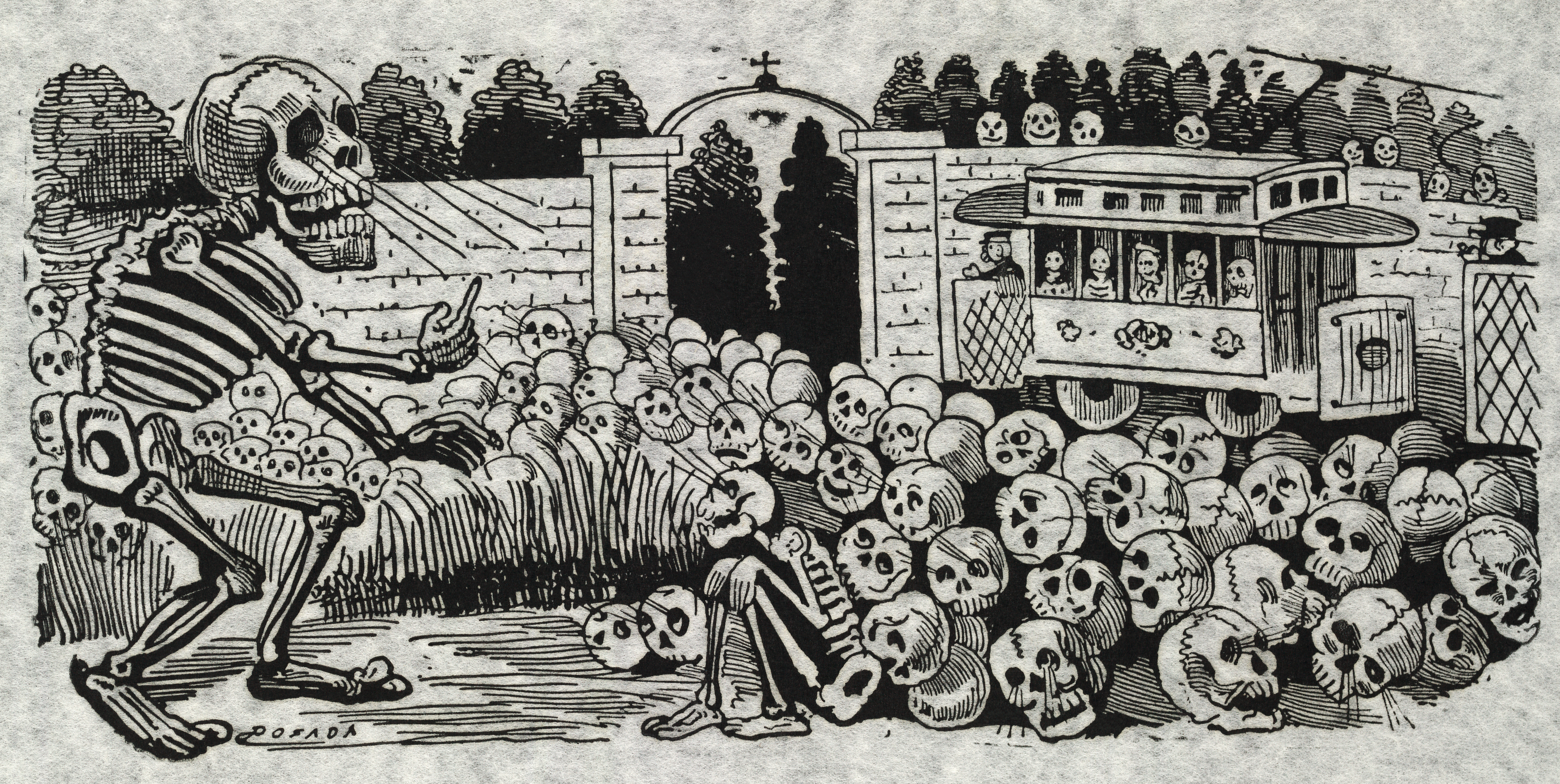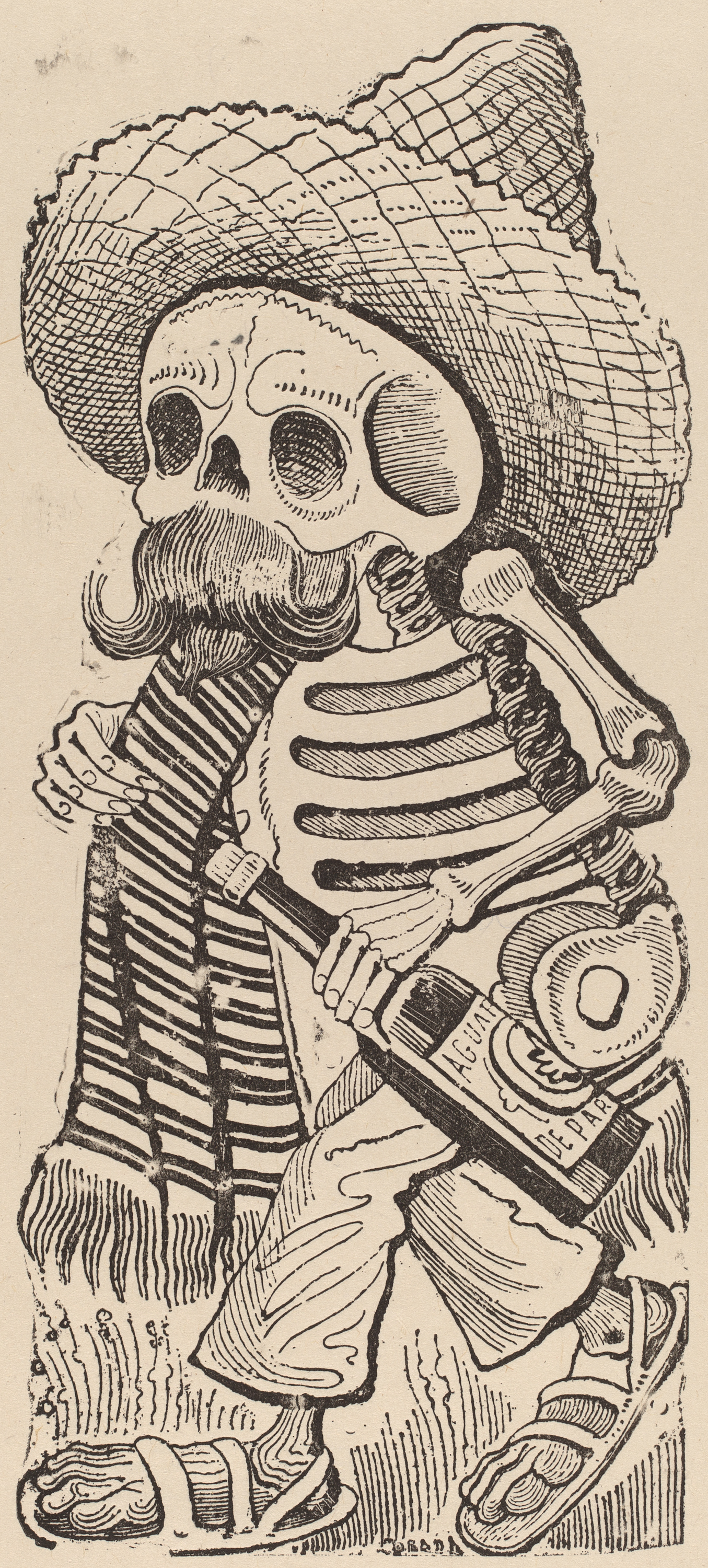José Guadalupe Posada on:
[Wikipedia]
[Google]
[Amazon]
José Guadalupe Posada Aguilar (2 February 1852 – 20 January 1913) was a Mexican political
 Posada was born in Aguascalientes on 2 February 1852. His father was Germán Posada Serna and his mother Petra Aguilar Portillo. Posada was one of eight children and received his early education from his older brother Cirilo, a country school teacher. Posada's brother taught him reading, writing and drawing. He then joined ''La Academia Municipal de Dibujo de Aguascalientes'' (the ''Municipal Drawing Academy of Aguascalientes''). Later, in 1868, as a teenager he apprenticed in the workshop of Jose Trinidad Pedroza, who taught him lithography and
Posada was born in Aguascalientes on 2 February 1852. His father was Germán Posada Serna and his mother Petra Aguilar Portillo. Posada was one of eight children and received his early education from his older brother Cirilo, a country school teacher. Posada's brother taught him reading, writing and drawing. He then joined ''La Academia Municipal de Dibujo de Aguascalientes'' (the ''Municipal Drawing Academy of Aguascalientes''). Later, in 1868, as a teenager he apprenticed in the workshop of Jose Trinidad Pedroza, who taught him lithography and


 He began to work with Antonio Vanegas Arroyo, until he was able to establish his own lithographic workshop. From then on Posada undertook work that earned him popular acceptance and admiration for his sense of humor and propensity concerning the quality of his work. In his broad and varied work, Posada portrayed beliefs, daily lifestyles of popular groups, the abuses of government, and the exploitation of the common people. He illustrated the famous skulls, along with other illustrations that became popular as they were distributed to various newspapers and periodicals.
In 1883, following his success, he was hired as a teacher of lithography at the local Preparatory School. The shop flourished until 1888 when a disastrous flood hit the city. He subsequently moved to Mexico City. His first regular employment in the capital was with ''La Patria Ilustrada'', whose editor was Ireneo Paz, the grandfather of the later famed writer
He began to work with Antonio Vanegas Arroyo, until he was able to establish his own lithographic workshop. From then on Posada undertook work that earned him popular acceptance and admiration for his sense of humor and propensity concerning the quality of his work. In his broad and varied work, Posada portrayed beliefs, daily lifestyles of popular groups, the abuses of government, and the exploitation of the common people. He illustrated the famous skulls, along with other illustrations that became popular as they were distributed to various newspapers and periodicals.
In 1883, following his success, he was hired as a teacher of lithography at the local Preparatory School. The shop flourished until 1888 when a disastrous flood hit the city. He subsequently moved to Mexico City. His first regular employment in the capital was with ''La Patria Ilustrada'', whose editor was Ireneo Paz, the grandfather of the later famed writer
 Academics have estimated that during his long career, Posada produced 20,000 plus images for broadsheets, pamphlets and chapbooks. Posada was studied by key figures of Mexican muralism. Mural artists inspired by Posada, such as
Academics have estimated that during his long career, Posada produced 20,000 plus images for broadsheets, pamphlets and chapbooks. Posada was studied by key figures of Mexican muralism. Mural artists inspired by Posada, such as
File:A rooster MET DP874465.jpg
File:A female soldier standing MET DP869603.jpg
File:A battle between Federal forces and Zapata followers MET DP869402.jpg
File:A child tipping a table over, his mother rushing to help MET DP867998.jpg
File:A drunken man with a bottle at his side in a field MET DP869600.jpg
File:A group of mother-in-laws flanked by two men MET DP869359.jpg
File:Broadsheet relating to the capture of Valentin Mancera who is shown playing the guitar and being cornered by men in uniforms carrying weapons MET DP868506.jpg
File:A girl with two faces MET DP869382.jpg
File:A man leaning over the side of a bed vomiting, from a broadside entitled 'Death of Aurelio Caballero due to yellow fever in Veracruz' MET DP869598.jpg
File:José Guadalupe Posada, Juego de la oca, ca. 1900.jpg
File:Flickr - …trialsanderrors - José Guadalupe Posada, Los charros contrabandistas, board game, ca. 1900.jpg
File:José Guadalupe Posada, Don Chepito, 1891-1899, NGA 163508.jpg
Posada Art Foundation
{{DEFAULTSORT:Posada, Jose Guadalupe 1852 births 1913 deaths 19th-century engravers 20th-century engravers Mexican engravers Mexican caricaturists Mexican illustrators Mexican printmakers People from Aguascalientes City 19th-century Mexican male artists 20th-century Mexican male artists Artists from Aguascalientes
lithographer
Lithography () is a planographic method of printing originally based on the immiscibility of oil and water. The printing is from a stone (lithographic limestone) or a metal plate with a smooth surface. It was invented in 1796 by the German a ...
who used relief printing
Relief printing is a family of printing methods where a printing block, plate or matrix, which has had ink applied to its non-recessed surface, is brought into contact with paper. The non-recessed surface will leave ink on the paper, whereas t ...
to produce popular illustration
An illustration is a decoration, interpretation or visual explanation of a text, concept or process, designed for integration in print and digital published media, such as posters, flyers, magazines, books, teaching materials, animations, vid ...
s. His work has influenced numerous Latin American
Latin Americans ( es, Latinoamericanos; pt, Latino-americanos; ) are the citizens of Latin American countries (or people with cultural, ancestral or national origins in Latin America). Latin American countries and their diasporas are multi-eth ...
artists and cartoonist
A cartoonist is a visual artist who specializes in both drawing and writing cartoons (individual images) or comics (sequential images). Cartoonists differ from comics writers or comic book illustrators in that they produce both the literary and ...
s because of its satirical acuteness and social engagement. He used skulls, calavera
A calavera (Spanish language, Spanish – for "skull") is a representation of a human skull. The term is most often applied to edible or decorative skulls made (usually by hand) from either sugar (called Alfeñiques) or clay, used in the Mexican ...
s, and bones to convey political and cultural critiques.
Among his most enduring works is ''La Calavera Catrina
''La Calavera Catrina ''("Dapper Skull") or ''Catrina'' ''La Calavera Garbancera'' ("Elegant Skull") is a 1910–1913 zinc etching by the Mexican printmaker, cartoon illustrator and lithographer José Guadalupe Posada. Originally a satirizat ...
''.
Early life and education
 Posada was born in Aguascalientes on 2 February 1852. His father was Germán Posada Serna and his mother Petra Aguilar Portillo. Posada was one of eight children and received his early education from his older brother Cirilo, a country school teacher. Posada's brother taught him reading, writing and drawing. He then joined ''La Academia Municipal de Dibujo de Aguascalientes'' (the ''Municipal Drawing Academy of Aguascalientes''). Later, in 1868, as a teenager he apprenticed in the workshop of Jose Trinidad Pedroza, who taught him lithography and
Posada was born in Aguascalientes on 2 February 1852. His father was Germán Posada Serna and his mother Petra Aguilar Portillo. Posada was one of eight children and received his early education from his older brother Cirilo, a country school teacher. Posada's brother taught him reading, writing and drawing. He then joined ''La Academia Municipal de Dibujo de Aguascalientes'' (the ''Municipal Drawing Academy of Aguascalientes''). Later, in 1868, as a teenager he apprenticed in the workshop of Jose Trinidad Pedroza, who taught him lithography and engraving
Engraving is the practice of incising a design onto a hard, usually flat surface by cutting grooves into it with a Burin (engraving), burin. The result may be a decorated object in itself, as when silver, gold, steel, or Glass engraving, glass ...
.
In 1871, before he was out of his teens, his career began with a job as the political cartoonist
An editorial cartoonist, also known as a political cartoonist, is an artist who draws editorial cartoons that contain some level of political or social commentary. Their cartoons are used to convey and question an aspect of daily news or curre ...
for a local newspaper in Aguascalientes, ''El Jicote'' ("The Bumblebee"), where his first cartoons were published. The newspaper closed after 11 issues, reportedly because one of Posada's cartoons had offended a powerful local politician. In 1872, Posada and Pedroza dedicated themselves to commercial lithography in León, Guanajuato. While in Leon, Posada opened his own workshop and worked as a teacher of lithography at the local secondary school. He also continued his work with lithographs and wood engravings. In 1873, he returned to his home in Aguascalientes City
(''Virtue in the Water, Fidelity in the Heart'')
, image_skyline = AGUASCALIENTES CITY.jpg
, imagesize =
, image_caption = Clockwise from top: San Antonio de Padua Church, La Exedra (main square), Aguascal ...
where he married María de Jesús Vela in 1875. The following year he purchased the printing press from Pedroza.
From 1875 to 1888, Posada continued to collaborate with several newspapers in León, including ''La Gacetilla'', ''el Pueblo Caótico'' and ''La education''. He survived the great flood of León on 18 June 1888, of which he published several lithographs representing the tragedy in which more than two hundred and fifty corpses were found and more than 1,400 people were reported missing.
At the end of 1888, he moved to Mexico City
Mexico City ( es, link=no, Ciudad de México, ; abbr.: CDMX; Nahuatl: ''Altepetl Mexico'') is the capital and largest city of Mexico, and the most populous city in North America. One of the world's alpha cities, it is located in the Valley o ...
, where he learned the craft and technique of engraving in lead and zinc. He collaborated with the newspaper ''La Patria Ilustrada'' and the ''Revisita de Mexico'' until the early months of 1890.
Career as artist


Octavio Paz
Octavio Paz Lozano (March 31, 1914 – April 19, 1998) was a Mexican poet and diplomat. For his body of work, he was awarded the 1977 Jerusalem Prize, the 1981 Miguel de Cervantes Prize, the 1982 Neustadt International Prize for Literature, and ...
. He later joined the staff of a publishing firm owned by Antonio Vanegas Arroyo and while at this firm he created a prolific number of book covers and illustrations. Much of his work was also published in sensationalist
In journalism and mass media, sensationalism is a type of editorial tactic. Events and topics in news stories are selected and worded to excite the greatest number of readers and viewers. This style of news reporting encourages biased or emo ...
ic broadsides depicting various current events.
From the outbreak of the Mexican Revolution
The Mexican Revolution ( es, Revolución Mexicana) was an extended sequence of armed regional conflicts in Mexico from approximately 1910 to 1920. It has been called "the defining event of modern Mexican history". It resulted in the destruction ...
in 1910 until his death in 1913, Posada worked tirelessly in the press. The works he completed in his press during this time allowed him to develop his artistic prowess as a draftsman, engraver and lithographer. At the time he continued to make satirical illustrations and cartoons featured in the magazine, ''El Jicote''. He played a crucial role for the government during the presidency of Francisco I Madero and during the campaign of Emiliano Zapata
Emiliano Zapata Salazar (; August 8, 1879 – April 10, 1919) was a Mexican revolutionary. He was a leading figure in the Mexican Revolution of 1910–1920, the main leader of the people's revolution in the Mexican state of Morelos, and the ins ...
.
Notable works
Posada's best known works are hiscalavera
A calavera (Spanish language, Spanish – for "skull") is a representation of a human skull. The term is most often applied to edible or decorative skulls made (usually by hand) from either sugar (called Alfeñiques) or clay, used in the Mexican ...
s, which often assume various costumes, such as the ''La Calavera Catrina
''La Calavera Catrina ''("Dapper Skull") or ''Catrina'' ''La Calavera Garbancera'' ("Elegant Skull") is a 1910–1913 zinc etching by the Mexican printmaker, cartoon illustrator and lithographer José Guadalupe Posada. Originally a satirizat ...
'', she is offered as a satirical portrait of those Mexican natives who, Posada felt, were aspiring to adopt European aristocratic traditions in the pre-revolution era.
Later life
Largely forgotten by the end of his life, José Guadalupe Posada died in 1913 ofgastroenteritis
Gastroenteritis, also known as infectious diarrhea and gastro, is an inflammation of the gastrointestinal tract including the stomach and intestine. Symptoms may include diarrhea, vomiting, and abdominal pain. Fever, lack of energy, and dehydra ...
. Three of his neighbors certified his death, although only one of them knew his full name.
Legacy
 Academics have estimated that during his long career, Posada produced 20,000 plus images for broadsheets, pamphlets and chapbooks. Posada was studied by key figures of Mexican muralism. Mural artists inspired by Posada, such as
Academics have estimated that during his long career, Posada produced 20,000 plus images for broadsheets, pamphlets and chapbooks. Posada was studied by key figures of Mexican muralism. Mural artists inspired by Posada, such as Diego Rivera
Diego María de la Concepción Juan Nepomuceno Estanislao de la Rivera y Barrientos Acosta y Rodríguez, known as Diego Rivera (; December 8, 1886 – November 24, 1957), was a prominent Mexican painter. His large frescoes helped establish the ...
and José Clemente Orozco catered to a Mexican elite that rejected foreign styles as part of their new-found bourgeois taste.
In the 1920s the US and Mexico based publicist Jean Charlot
Louis Henri Jean Charlot (February 8, 1898 – March 20, 1979) was a French people, French-born United States, American Painting, painter and illustrator, active mainly in Mexico and the United States.
Life
Charlot was born in Paris. His father, ...
popularized Posada's broadsides. In 1929 Anita Brenner
Anita Brenner (born Hanna Brenner; 13 August 1905 – 1 December 1974) was a transnational Jewish scholar and intellectual, who wrote extensively in English about the art, culture, and history of Mexico. She was born in Mexico, raised and educa ...
's book ''Idols Behind Altars'' used Posada's illustrations. Brenner called Posada a ''prophet'' and linked him to the Mexica
The Mexica (Nahuatl: , ;''Nahuatl Dictionary.'' (1990). Wired Humanities Project. University of Oregon. Retrieved August 29, 2012, frolink/ref> singular ) were a Nahuatl-speaking indigenous people of the Valley of Mexico who were the rulers of ...
, peasant
A peasant is a pre-industrial agricultural laborer or a farmer with limited land-ownership, especially one living in the Middle Ages under feudalism and paying rent, tax, fees, or services to a landlord. In Europe, three classes of peasants ...
s and workers. The US author Frances Toor Frances Toor (1890–1956) was an American author, publisher, anthropologist and ethnographer who wrote mainly about Mexico and Mexican indigenous cultures. She earned a B.A. and an M.A. in anthropology from University of California at Berkeley. Sh ...
promoted Posada as folklore with her 1930 book ''Posada: Grabador Mexicano,'' the first monograph
A monograph is a specialist work of writing (in contrast to reference works) or exhibition on a single subject or an aspect of a subject, often by a single author or artist, and usually on a scholarly subject.
In library cataloging, ''monograph ...
on Posada. Rivera commented on 406 engravings by Posada in the foreword for the book.
When Leopoldo Méndez
Leopoldo Méndez (June 30, 1902 – February 8, 1969) was one of Mexico's most important graphic artists and one of that country's most important artists from the 20th century. Méndez's work mostly focused on engraving for illustrations and othe ...
returned from the Cultural Missions programs of the Mexican Secretariat of Public Education in Jalisco
Jalisco (, , ; Nahuatl: Xalixco), officially the Free and Sovereign State of Jalisco ( es, Estado Libre y Soberano de Jalisco ; Nahuatl: Tlahtohcayotl Xalixco), is one of the 31 states which, along with Mexico City, comprise the 32 Federal En ...
, Méndez got to know about Posada's prints and adopted him as artistic and cultural hero. One of Méndez's last projects was a study of Posada, where Méndez reproduced over 900 Posada illustrations.
See also
* Nota rojaReferences
External links
* José Guadalupe Posada prints, 1880-1943, Getty Research Institute, Research Library, Accession no. 960060.Posada Art Foundation
{{DEFAULTSORT:Posada, Jose Guadalupe 1852 births 1913 deaths 19th-century engravers 20th-century engravers Mexican engravers Mexican caricaturists Mexican illustrators Mexican printmakers People from Aguascalientes City 19th-century Mexican male artists 20th-century Mexican male artists Artists from Aguascalientes